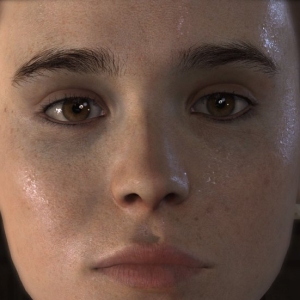I wonder if David Cage revels in being different? His studio Quantic Dream makes games different (and differently) from their peers. With the 2010 psychological thriller Heavy Rain, the studio orchestrated a coming-together of video games and film noir. In 2012, Kara the short film showed off their advanced graphics and motion capturing technology. And in 2013, Beyond: Two Souls they create their own concept of a modern adventure game that not only places emphasis on the themes of love, loss, and consequence but gets an injection of super-natural action, a top-notch Hollywood cast, and a story that spans 15 years. Seems like a great setup then, but is this form of interactive movie worth your time and money?
An 84 MB patch later and a (mercifully) short installation later, a typical in-media-res moment introduces a mysterious girl who wants to tell us her story. We’re about to live the life of Jodie Holmes, a gifted woman who has an otherworldly connection to a mysterious invisible entity from her childhood: Aiden. Through a series of non-linear vignettes, we’re taken back and forth in the timeline of Jodie, through 26 pivotal points in her life that shape the person who she becomes.
If you have played Heavy Rain, you’ll be at home with Beyond. There is nary a health bar or ammo counter in sight, and the control scheme sticks to its minimalist roots while refining it for the more action-oriented parts of the game. A plain white dot shows the point of interaction the player has in the world of Beyond. The left stick controls movement, and the right is used to interact with objects. Sometimes it’s obvious which direction you need to move the stick; at other times, you’re wiggling it in all directions just to get the desired response. During the fast hand-to-hand combat scenes, it can be difficult to figure out which direction to push the right stick in the limited amount of time. When someone is taking a swing at you, the natural reaction would be to avoid it but it turns out you have on the offensive. However, at other times you’re meant to be ducking away from it. It’s not all that intuitive. But you can’t fail if you don’t time it right, Jodie just gets more of a beatdown.
You can’t fail in Beyond. There is no game over screen where the player is offered to retry from the last checkpoint. “Failure” here means the story carries on, there’s never a loss of continuity. For example, in a point of the game, Jodie is aboard a train and the cops are on the look out for her. You could allow her to be arrested, or you could do a runner. The latter leads to a thrilling and terrifying chase where she could get caught, or escape to freedom. There is always an alternate story path to follow.
For the majority of the game, you switch between Jodie and Aiden. Jodie’s view is from the third-person while Aiden’s is the free-roam first person view. Aiden’s interactions with the world and enemies is limited. Sometimes he can possess them and command them to do his bidding, and other times he simply robs them of life. You can’t choose which, the game decides for you.
Beyond can be played in one of two modes: solo or duo. Both are self-explanatory, but here’s a fun thing you may not have expected. The Beyond companion app (available on Android and iOS) enables you to use you mobile device as a controller to the game. The connection is dead simple: start up the game and then the app, and Beyond detects the mobile device as an alternate controller. The majority of Jodie’s and Aiden’s action are mapped to taps and directional swipes on the screen. To look around, you tap and hold an area of the screen and drag your finger around the screen to look around. Swipe backwards and Aiden topples objects off tables, and swiping in the required direction gets Jodie punching and kicking her way out of hostile situations. In fact, I found the app controls are better suited to the latter than the PS3 controller. However, when you play as Aiden, you’re not as free to explore. Unlike with the PS3 controller, where you use the left analog stick to guide Aiden around the environment, the app places a few beacons around the room to which Aiden is forced to make a beeline for. It’s probably the only hiccup in this otherwise great touch-sensitive controller.
There are opportunities in the game to make decisions on what Jodie should do and say. Depending on how much you’re drawn into the games, these decisions can often times be instinctive and personal. In one situation, Jodie was mocked by teenagers at a party and cruelly locked up under the stairs. When Aiden helped her escape, she had a choice to leave or exact revenge. It’s not something I’d ever do in real life, but in the game, in the heat of the moment, I chose revenge. And I liked it. I’m sure that is what David Cage was expecting. For the player to share a bond to Jodie (as she does to Aiden) and react as they would if they were in her situation. Through the fifteen years that we see of Jodie’s life, from troubled childhood to an equally strained life as a woman, the roller coaster of emotions she goes through isn’t something we’re unfamiliar with: angst, anger, love, uncertainty, abandonment, loss, revenge, sacrifice. Whether man or woman, we can identify with these base feelings, and Beyond crafts scenes around these themes to draw us in. It’s done this better than any other game that I have played in recent history.
It’s not just changes to her emotional state, we see the very physical effects that this life has on Jodie, from the changes in hair, her stance and movement, and especially the look in her eyes, particularly during what is probably the bleakest phase in her life. We are able to see this in such great detail, and thanks to the fancy performance capture. And upgrade to motion capture, performance capture allows for facials expressions and body movements to be recorded together, for a more cohesive, and realistic result. The graphics in Beyond are impressive to say the least. We’re able to see the characters’ emotions written right on their faces in stunning detail. The hair on their heads looks pretty good too. It’s rather spooky to see them almost look like their real selves, Willem Dafoe with his weird teeth and eccentric looks, and Ellen Page who is as cute as a button. They both deliver their lines perfectly, almost like they were predestined to play these parts. Composers Lorne Balfe (Assassin’s Creed III) and Hans Zimmer (Pirates of the Caribbean, amongst many, many others) provide a fantastic (if a tad melancholic) score that is in simpatico with the story and its tragic twists and turns.
Reactions to Beyond have been polarising. Gamers are used to pressing a myriad of buttons to controller their characters, and Beyond pares that down to the most minimal movements and QTE actions. The disrupted non-linear narrative can be confusing at first, but when all the puzzles pieces come together, they lead to a personal and profound moment. The performances from its actors are phenomenal and the beautiful graphics help to bond you to the characters, to their triumphs and to devastating lows that life has to offer. Beyond is completely compelling, an interactive experience that is ever closer to blurring the lines between video games and film.
Final score: 10 dramatic prawns out of 10
Detailed information:
Developer: Quantic Dream
Publisher: Sony Computer Entertainment
Distributor: Ster-Kinekor
Platforms: PS3 (reviewed)
Age Rating: 16
Official Website: http://beyond.eu.playstation.com/





